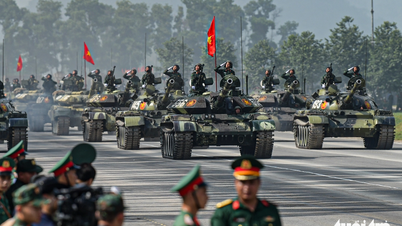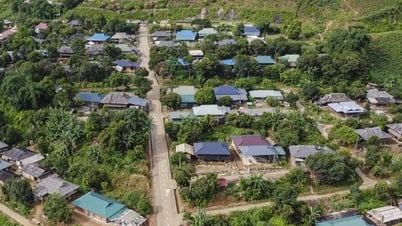According to legend and old historical documents, during the Hung King period, Tuyen Quang belonged to the Van Lang department; during the Northern domination period, it was the land of Giao Chi district, then Tan Xuong district and Tan Hung district.

Uncle Ho talking to people at Tan Trao communal house in 1961. Photo archive
The name Tuyen Quang appeared earliest in ancient books in our country in the book "An Nam chi luoc" by Le Tac, compiled in China in 1335. The book says: "Quy Hoa river flows from Van Nam, Tuyen Quang water flows from Dac Ma dao, Da river water flows from Chang Long, because of the confluence of three rivers, it was named like that". It is possible that at that time the name Tuyen Quang originated from the name of a river, Tuyen Quang river (now Lo river) which later authors wrote about: Cao Hung Trung (Ming Dynasty) wrote in "An Nam chi nguyen": Tuyen Quang river is in Khoang district; author Nguyen Van Sieu wrote in "Dai Viet dia du toan bien": Tuyen Quang river is in the north of Giao Chau prefecture; author Dang Xuan Bang wrote in "Su hoc bi khac": Tuyen Quang river originates from Giao Hoa district and flows in.
During the Tran Dynasty (13th-14th century), Tuyen Quang had the administrative name "Lo". The inscription engraved on the bell at Bach Hac Thong Thanh Quan (Viet Tri, Phu Tho ), cast in the 8th year of Dai Khanh, during the reign of King Tran Minh Tong (1321) talked about the resistance war against the Yuan army of the Tran Dynasty as follows: "At the end of winter in the year Giap Than (1284), the Northern invaders (referring to the Yuan-Mongol army) came to invade. At that time, Khai Quoc Vuong Tran Nhat Duat was stationed at the Tuyen Quang routes. In the year At Dau (1285) at Bach Hac river, he cut his hair and swore to the gods to show his loyalty to repay the king...". Also according to Le Quy Don, at the end of the Tran Dynasty, Tuyen Quang was also called "Tran": Tran Tuyen Quang, the court appointed the position of Phieu Ky Dai Tuong Quan to command.
However, before the Tran Dynasty, Tuyen Quang's administration was not stable. At that time, Tuyen Quang was the land of ethnic minority chieftains, they took "Chau" as their own territory (Kimi Chau), little dependent or loosely dependent on the central feudal court, such as: Chau Do Kim (now Ham Yen), Chau Vi Long (now Chiem Hoa)... therefore, the kings of the Ly-Tran dynasties all used the "vien nhu" policy to ensure border security and maintain national unity.
When the Ming invaders occupied our country, they established the administrative foundation of Tuyen Quang in the "Phu" called Phu Tuyen Quang, later changed to Chau Tuyen Hoa. At that time, Phu Tuyen Quang had 9 districts: Duong Dao, Van Yen, Binh Nguyen, De Giang, Thu Vat, Dai Man, Khoang, Duong, At. The head of the prefecture was the prefect, the head of the district was the district chief.
During the early Le Dynasty (15th-16th centuries), to strengthen the state's management of the border regions, in 1466, Le Thanh Tong divided our country into 12 regions, Tuyen Quang became a Thua Tuyen Region consisting of one prefecture (the capital was Yen Binh), one district (Phuc Yen) and 5 states: Thu Vat, Luc Yen, Dai Man, Binh Nguyen, Bao Lac. The head of the Thua Tuyen Region was the Do Ty, below was the Thua Ty. In 1469, King Le Thanh Tong re-established the map of the 12 regions, and the Tuyen Quang Thua Tuyen Region had one prefecture (Yen Binh), one district (Phuc Yen) and 5 states: Thu Vat, Luc Yen, Dai Man, Binh Nguyen, Bao Lac; a total of 223 communes, 11 wards, 2 villages, 1 page, 7 caves. By the year Hong Duc 21 (1490), the Thua Tuyen Region was renamed Tuyen Quang, the names of the prefectures and districts remained unchanged.
When Gia Quoc Cong Vu Van Mat had the merit of assisting Le in defeating Mac, he was given control of a large area of land including Tuyen Quang and Hung Hoa prefectures (Phu Tho and Vinh Phuc ) and named it Dinh An Tay (the center is Dai Dong land, now An Khang commune). The Vu family was hereditary for 5 generations, a total of 142 years, from Vu Van Uyen in the 6th year of Thong Nguyen (1527) to the 7th year of Canh Tri (1669). In 1669, Vu Cong Tuan on his way back from the capital to carry out a plot of rebellion was chased and killed by the capital's Governor, Dien Quan Cong Trinh Ac, who brought troops to chase and kill him. After this event, the Le dynasty abolished the hereditary rights of the Vu family, divided the area into 2 towns: Tuyen Quang and Hung Hoa, and appointed a governor to rule as before.
At the beginning of the Nguyen Dynasty (19th century), the names of administrative units of Tuyen Quang were basically kept as in the Le Dynasty. In 1831, King Minh Mang carried out administrative reforms throughout the country, Tuyen Quang became a province under the control of Governor-General Son-Hung-Tuyen. The geographical area of Tuyen Quang province at this time was recorded by historians as follows: to the north it bordered Yunnan, Guangxi (China), to the south it bordered Doan Hung prefecture, to the west it bordered Hung Hoa province, to the east it bordered Cao Bang and Thai Nguyen provinces. The first Governor-General was the Military Minister Dich Trung Tu Hoang Ke Viem. By the 16th year of Minh Mang (1833), Yen Binh prefecture was divided into 2 prefectures, Yen Binh and Yen Ninh, and the districts and counties from the Le Dynasty also had many changes:
1- Yen Binh Prefecture: was established in the 7th year of Quang Thuan (1466) and kept its name through many historical periods. The prefecture's territory is very large, including 2 districts: Thu Vat, Luc Yen and 2 districts: Ham Yen, Vinh Tuy.
- Chau Thu Vat: named Thu Vat camp during the Tran Dynasty, kept the same during the Ming Dynasty, and during the Le Dynasty, changed its name to Thu Chau in the 3rd year of Minh Mang (1822), including 8 communes, 39 villages, and hamlets. After 1945, it was changed to Yen Binh district (now Yen Binh district, Yen Bai province).
- Chau Luc Yen: originally the name of a district from the Le dynasty, belonging to Yen Binh prefecture, including 6 cantons, 27 communes and villages (now Luc Yen district, Yen Bai province).
- Ham Yen district: in the Dinh-Tien Le period (10th century) it was called Soc Sung, in the Ly period it was called To Mau district, later changed to Do Kim district, during the Ming period it was Van Yen district. At the beginning of the Le period it was changed to Sung Yen district, in 1466 it was changed to Phuc Yen district (under Yen Binh prefecture). In the 3rd year of Minh Mang (1822) it was changed to Ham Yen district, including 10 cantons, 62 communes, streets, villages, and camps (now Ham Yen district and part of Yen Son district, Tuyen Quang city).
- Vinh Tuy District: originally belonged to Vi Xuyen District. In 1833, Vi Xuyen District was divided into Vi Xuyen District (belonging to Tuong An Prefecture) and Vinh Tuy District, including 6 cantons, 28 communes and villages (now Hoang Su Phi District, Ha Giang Province).
2- Yen Ninh Prefecture: established in 1833 by separating from Yen Binh Prefecture, in the 2nd year of Thieu Tri (1842), Yen Ninh Prefecture was changed to Tuong An Prefecture, including Chiem Hoa Prefecture and 3 districts: Vinh Dien, De Dinh, Vi Xuyen:
- Chau Chiem Hoa: before the Tran Dynasty, it was Chau Vi Long, during the Ming Dynasty it was named Chau Dai Man. In the 14th year of Minh Mang (1833), after the Nguyen Dynasty suppressed the uprising of the local chief Nong Van Van, in 1835 it was changed to Chau Chiem Hoa, with 4 cantons, 40 communes, villages, streets, hamlets, and camps (now Chiem Hoa district and Na Hang district).
- Vi Xuyen district: during the Ming Dynasty, it was Binh Nguyen district. During the Mac Dynasty (16th century), due to avoiding the taboo name of King Mac's wife, it had to be changed to Vi Xuyen district. In the 14th year of Minh Mang (1833), Vi Xuyen district was divided into two districts: on the right bank of Lo River, it was Vinh Tuy district, including 6 cantons, 28 communes and villages (now Hoang Su Phi district, Ha Giang province) and on the left bank of Lo River, it was Vi Xuyen district, including 5 cantons, 31 communes (now Bac Quang district, Ha Giang province).
- Chau Bao Lac: was a district belonging to An Binh prefecture since the Le dynasty. In 1835, after suppressing Nong Van Van's uprising, the Nguyen dynasty abandoned the name Chau Bao Lac and split it into two districts: De Dinh, including 2 cantons and 9 communes, and Vinh Dien, including 2 cantons and 11 communes (now Bao Lac district, Cao Bang province).
During the French colonial period, the administrative organization of Tuyen Quang province had many changes. On September 9, 1891, the Governor-General of Indochina issued a decree to establish 4 military districts in Bac Ky, dividing the territory of Tuyen Quang province into Military District 2 and Military District 3. On April 11, 1900, the Governor-General of Indochina issued a decree to re-establish Tuyen Quang province, the provincial capital was located in Y La commune, including: Yen Binh district, Son Duong district of Son Tay province was merged into Tuyen Quang province, in 1913, Son Duong district was changed into Son Duong district. In 1916, Ham Yen district was separated into Yen Son district and Ham Yen district, Tuong An district (old Yen Ninh) and 3 districts: Bao Lac (old), Vi Xuyen, Vinh Tuy were established as Ha Giang province, Luc Yen district was merged into Yen Bai province.
Before the success of the August Revolution (1945), Tuyen Quang had 1 Yen Binh prefecture concurrently governing 4 districts: Yen Son, Ham Yen, Chiem Hoa, Son Duong, the provincial center was located in Y La commune (Ham Yen), the provincial government was located in the northeast of Tuyen Quang ancient citadel (Mac Dynasty citadel), the population was 8,591 people, the land was 42,149 hectares, the Man people had 1,532 people.
The article uses materials from: Dai Viet Su Ky Toan Thu, An Nam Magazine, Tuyen Quang Tinh Phu, Tuyen Quang Phong Tho Ky; documents such as inscriptions, royal decrees, genealogies...
Provincial Information Portal





































































































Comment (0)